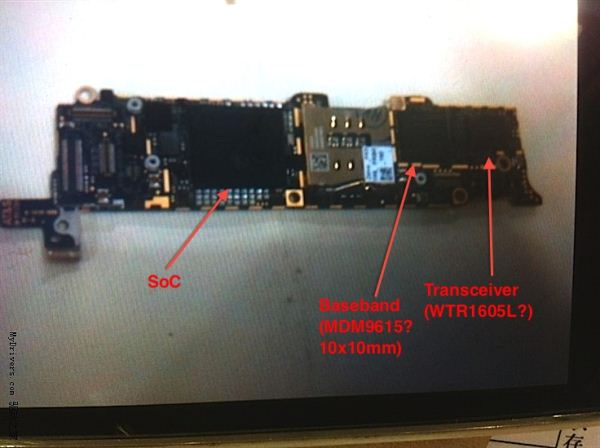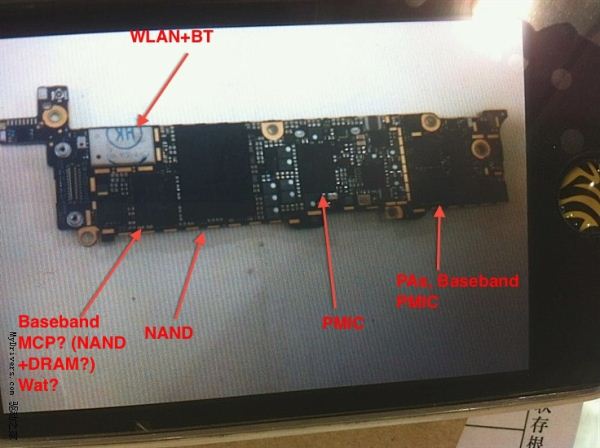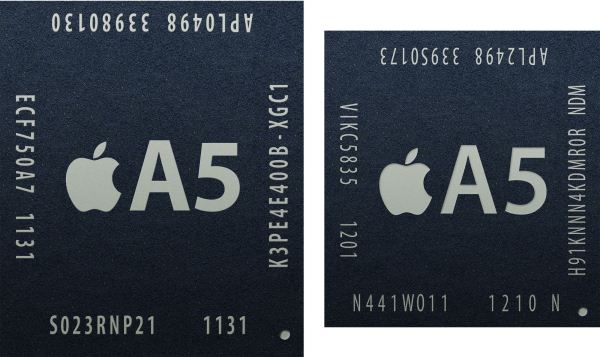Preparing for the iPhone Next: Rumors Analyzed
by Brian Klug & Anand Lal Shimpi on August 27, 2012 9:40 PM EST- Posted in
- Smartphones
- Apple
- Mobile
- iPhone
The SoC: 32nm A5R2?
So much of any new iPad/iPhone release is tied to the SoC. Apple remains one of the only handset designers that aggressively specs its own SoC rather than picking up an off the shelf part. As of late, Apple has used its control over its own SoC architecture to better match its chip architectures to the needs of its high resolution displays. Apple continues to produce its custom-designed SoCs at Samsung, although it's likely that Apple will consider other foundries at the 20nm node.


Rumored upcoming PCB, annotations ours
Most early looks at the next iPhone's internals show no silkscreened part numbers on the SoC. We've already seen blurry photos of the suspected upcoming PCB leak, though they're far too low quality to make out any chip markings. Given Apple's history, it's likely we'll see a 32nm LP (HK+MG) variant of the A5 SoC used in the iPhone 4S - perhaps at higher clocks. The move to a smaller process node should bring about a tangible increase in battery life. Depending on the workload, the iPhone 4S could burn more power than the iPhone 4 thanks to its beefy CPU + GPU combination. The move to 32nm could easily offset this penalty.
We've seen Apple experiment with Samsung's 32nm LP process in the past. Both the current generation Apple TV and the iPad 2,4 use a 32nm A5. In the case of the iPad 2,4, we saw a huge increase in battery life as a result of the move to 32nm. Some of the gains in battery life in the iPhone are likely to be offset by higher CPU/GPU clocks, but this is still the most likely approach for Apple this generation.

Original A5 (45nm, S5L8940, left), A5R2 (32nm, S5L8942, right)
As we mentioned back during our review of the iPad 2,4, it makes sense to test a new/unfamiliar process on a low volume part. By shipping 32nm A5 SoCs into some iPad 2s and the Apple TV (a hobby product), Apple could ride the 32nm yield curve up without adversely impacting shipments of its key money makers. With Samsung's 32nm LP process likely seeing much better yields now, it's time to deploy it in the next iPhone. Given much of the competition has moved to TSMC's 28nm process, Apple must remain competitive on the process node front as well. Shipping a 45nm SoC at the end of 2012 simply doesn't make sense. Although the current legal battles with Samsung could impact the relationship on the foundry side, simply switching to Global Foundries or TSMC is easier said than done. I would expect Apple to go through the same careful transition between Samsung and any other foundry as it did when it introduced the first 32nm A5s into the mix. The current expectations here are that we'll see Apple look at TSMC at the 20nm node.
With process node pretty much guaranteed, there's the question of CPU and GPU architectures.
Since the release of the original iPad, Apple has used the spring to introduce new SoC architectures in the iPad and later waterfall them down to the iPhone in the summer/fall. The A5X in the 3rd generation iPad however is still built on Samsung's 45nm LP process and is huge as a result of integrating four PowerVR SGX543 cores and implementing a 4 x 32-bit memory interface. The A5X needed the GPU power and memory bandwidth to drive the new iPad's retina display, but that power would be largely lost on the next iPhone.
The new iPhone is expected to have a 640 x 1136 resolution, thanks to its taller 4-inch display, but that's only 18% more pixels than the current iPhone 4S. A doubling of memory bandwidth and GPU compute horsepower would seem a bit excessive for current workloads. A ~20% increase in GPU clock speed, and faster DRAM would be enough to maintain current levels of performance on the higher resolution display.
Apple decoupled major cellular architecture and CPU architecture shifts in the past (e.g. iPhone 3G/3GS transition), which lends credibility to the idea of a move to A15 next year with the 4th gen iPad and sticking with the dual-core A9 design for the next iPhone. There's also the fact that TI is expected to be one of the first to bring an ARM Cortex A15 based SoC to market, and even it hasn't demonstrated an OMAP 5 running at shipping CPU clocks yet. I don't doubt that it's possible to ship an A15 based SoC before the end of the year, but based on the demos we've seen thus far, it seems highly unlikely to see one shipping in Q3. Apple doesn't like to be overly risky on the component front. There's nothing worse than a poorly yielding or otherwise problematic chip holding up shipments of one of your biggest revenue generators.










131 Comments
View All Comments
alxx - Tuesday, August 28, 2012 - link
but do ordinary consumers really care about whats under the hood(unlike us) ?A phone that works and with good battery life.
And whats on special at the carriers with a decent plan wins over the phone choice most of the time.
swb311 - Tuesday, August 28, 2012 - link
False, iOS is a thrifty OS that uses resources far better and efficiently than an off-the-shelf component thanks to Apple's custom designed silicon. So it may not look the same on paper, but the processor will feel just as fast. No one needs a quad core phone yet (apps are not prepared) so why take the battery hit? I'd rather have an upclocked dual core honestly.KoolAidMan1 - Tuesday, August 28, 2012 - link
"The iPhone is the new dumbphone"Considering that the iOS app selection is the best and largest of any mobile ecosystem, I'd say no, pretty much the opposite
KoolAidMan1 - Tuesday, August 28, 2012 - link
"they mgiht go for dual A9 (they certainly won't go quad) but that's so far behind the top phones"Even most PC applications don't use quad-cores, forget smartphones. No smartphone multitasks applications enough where quads would really matter. We're a few years away from where quad core SoCs are needed in cellphones. Until then it is marketing for neckbeards who look at spec pages without regard to practical usage scenarios or performance.
iampivot - Monday, August 27, 2012 - link
What about a fingerprint scanner?It seems obvious that one could be included in the home button, which would facilitate instantaneous verification of the user when doing NFC purchases.
8steve8 - Tuesday, August 28, 2012 - link
no a15?A5 - Tuesday, August 28, 2012 - link
Won't be ready and it wouldn't fit Apple's supply chain model to take a risk like that on the CPU. The article lays out the reasoning pretty clearly.iwod - Tuesday, August 28, 2012 - link
Not a faster SoC really annoys me, Krait from Qualcomm and Tegra etc... Quad Core ARM A9,a simple die shrinks? Or may be they bump the Frequency to 1.5Ghz or higher?
Dekker - Tuesday, August 28, 2012 - link
Even in the PC world the benefit of quad core is limited for many types of usage (email, web and office hardly benefit at all). I'm not convinced that absent a proper multitasking model in Android/iOS there is much benefit to going quad core (particularly if it reduces battery life). At this stage a slightly faster clock or more memory seems to be a more viable approach.iwod - Tuesday, August 28, 2012 - link
On PC we have Dual Thread from Single Core which accounts for 4 Threads with Dual Core. Mobile Dual Core we are still stuck at 2 threads. For the usage on mobile 4 threads will properly bring less benefits then on Desktop, but still large enough to warrant it. Having more then 2 threads for running the OS and Apps would help. Although we may wait big.LITTLE for that. Dual Core Cortex A7 + Dual Core Cortex A15.The Samsung GS3 has 4 Core 1.4Ghz SoC, I will have to see how Apple will pull its marketing and convince me to buy a Phone that is MUCH less powerful, and possibly even more expensive.